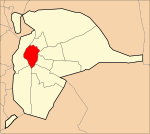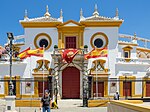Puerta Real (Seville)

The Puerta Real, called until 1570 as Puerta de Goles (believed to be a Muslim degeneration of the name of Hercules, whose effigy crowned the gate), was one of the gates of the walled enclosure of the city of Seville (Andalusia). It was located at the confluence of the calles de Alfonso XII, Gravina, Goles and San Laureano, and today only is it a cloth of the wall on which it was based, in which there is embedded a stone that was part of the gate.It is considered one of the gates that arose during the expansion of the Sultan Ali ibn Yusuf (1083-1143) and therefore from the Almoravid time of the city. The historians Rodrigo Caro and Peraza, relying on a legend, they attribute its origin to Julius Caesar, considering the name Goles as a degeneration of Hercules, whom the legend says it was dedicated. It was completely rebuilt in 1565, eliminating all the military matters before it, and inside it housed a chapel dedicated to the Our Lady of Mercy and another to the Christ of Redemption. It was torn down in 1862, and in 1995 were carried out works on the canvas of existing wall, where states the former existence of the gate.
Excerpt from the Wikipedia article Puerta Real (Seville) (License: CC BY-SA 3.0, Authors, Images).Puerta Real (Seville)
Calle San Laureano, Seville Casco Antiguo
Geographical coordinates (GPS) Address Nearby Places Show on map
Geographical coordinates (GPS)
| Latitude | Longitude |
|---|---|
| N 37.3933 ° | E -6.00152 ° |
Address
Capilla de Nuestra Señora de las Mercedes
Calle San Laureano
41001 Seville, Casco Antiguo
Andalusia, Spain
Open on Google Maps











